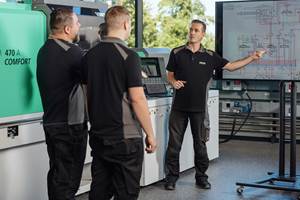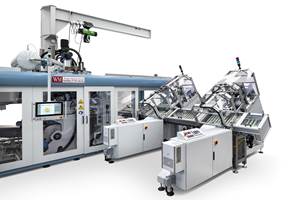The winning center console carrier was on display at Formnext 2024 in the Hans Weber booth, alongside a live 3D printing demo. The 3D printed part weighs about 4 kg and measures 300 × 300 × 1,000 mm.
In June 2024, the SPE Central Europe AutomotiveAward honored a 3D printed component for the first time in its history. The year’s grand award winner was a center console carrier created for a BMW Group vehicle, which is headed for production in 2027. The console is one of the largest 3D printed polymer components to be used in a commercial automobile to date, and stands to significantly reduce both the manufacturing complexity and carbon footprint of the overall vehicle.
The 3D printed version of the center console consolidates seven parts from the conventional assembly down to just one part produced through large-format additive manufacturing (LFAM). Rather than rely on injection molding (requiring a large, expensive tool) for the main body of the console and subsequent assembly work of parts from various suppliers, BMW can produce these new consoles in one piece with robot-based 3D printers supplied by the additive division of Hans Weber Maschinenfabrik. Each console can be 3D printed in about 3 hours and 40 minutes on the latter’s DXR platform MEX or LSP systems equipped with a single-screw Weber AE 20 extruder; only minimal machining is required before the component can be finished and installed.
Hans Weber demonstrated 3D printing of this component during Formnext 2024, using its own extruder technology coupled with an industrial robot.
Notably, the design integrates two air ducts that would otherwise need to be manufactured separately through a tooling-based molding process. 3D printing enabled integrating these air ducts in a more ideal route through the console, while also reducing overall manufacturing and assembly operations.

The conventional center console carrier (foreground) is seven components and incorporates multiple molded and sheet metal fabricated pieces. The 3D printed version is just one 3D printed piece, including the air ducts. Source: Hans Weber Maschinenfabrik GmbH
About 18,000 3D printed center console carriers will be needed annually. In production, the components will be 3D printed in-house by BMW, using Hans Weber robotic 3D printers and Akromid PA11 material from Akro-Plastic. Unlike smaller fused filament fabrication (FFF) 3D printers, Hans Weber’s large-scale DXR printers operate through fused granulate fabrication (FGF) or “direct extrusion” which enables 3D printing with readily available pellet materials, the same as those used in many molding processes, as opposed to filaments or powders created specially for additive. The Akromid material contains 40% recycled carbon fiber and renewable raw materials.
The material choice and design help to reduce the weight of the center console by 30% compared to the assembled version, which will enable better energy efficiency. The combination of recycled and renewable material, reduced weight, and overall optimization represented by the center console has resulted in a savings of about 70 kg of carbon for the entire vehicle.

The 3D printed center console with finishing touches; about 18,000 of these components will be 3D printed per year for BMW Group’s small-run vehicle. Source: Hans Weber Maschinenfabrik GmbH
About the Author
Stephanie Hendrixson reports on 3D printing technology and applications as executive editor for Additive Manufacturing. She is also co-host of The Cool Parts Show, a video series that highlights unique, unusual and weird 3D printed parts, and co-host and creator of the AM Radio podcast. SUBSCRIBE HERE
Related Content
ICIS Launches: Ask ICIS Generative AI Commodities Assistant
Said to be the first of its kind, this AI assistant will enhance access to ICIS’ intelligence and insights for the energy and chemical markets.
Read MoreFive Ways to Increase Productivity for Injection Molders
Faster setups, automation tools and proper training and support can go a long way.
Read MorePolyJohn Turns to Blow Molding, Doubles Its Productivity
Leading maker of portable sanitation products knew thermoforming, sheet extrusion, rotomolding and injection molding. Then it found the missing link to higher productivity and new markets: blow molding.
Read MoreAutomation in Thermoforming on the Rise
Equipment suppliers’ latest innovations exemplify this trend driven by factors such as labor shortages, higher-speed thermoformers and tighter quality control.
Read MoreRead Next
BMW Expands Use of Additive Manufacturing to Foster Production Innovations
The BMW Group is manufacturing many work aids and tools for its own production system using various 3D printing processes, with items such as tailor-made orthoses for employees, teaching and production aids, and large, weight-optimized robot grippers, which are used for such things as carbon fiber-reinforced polymer roofs and entire floor assemblies.
Read More8 Cool Parts From Formnext 2024: The Cool Parts Show #78
End-use parts found at Formnext this year address various aspects of additive's advance, notably AM winning on cost against established processes.
Read MoreMaking the Circular Economy a Reality
Driven by brand owner demands and new worldwide legislation, the entire supply chain is working toward the shift to circularity, with some evidence the circular economy has already begun.
Read More

.jpg;width=70;height=70;mode=crop)









.jpg)



















